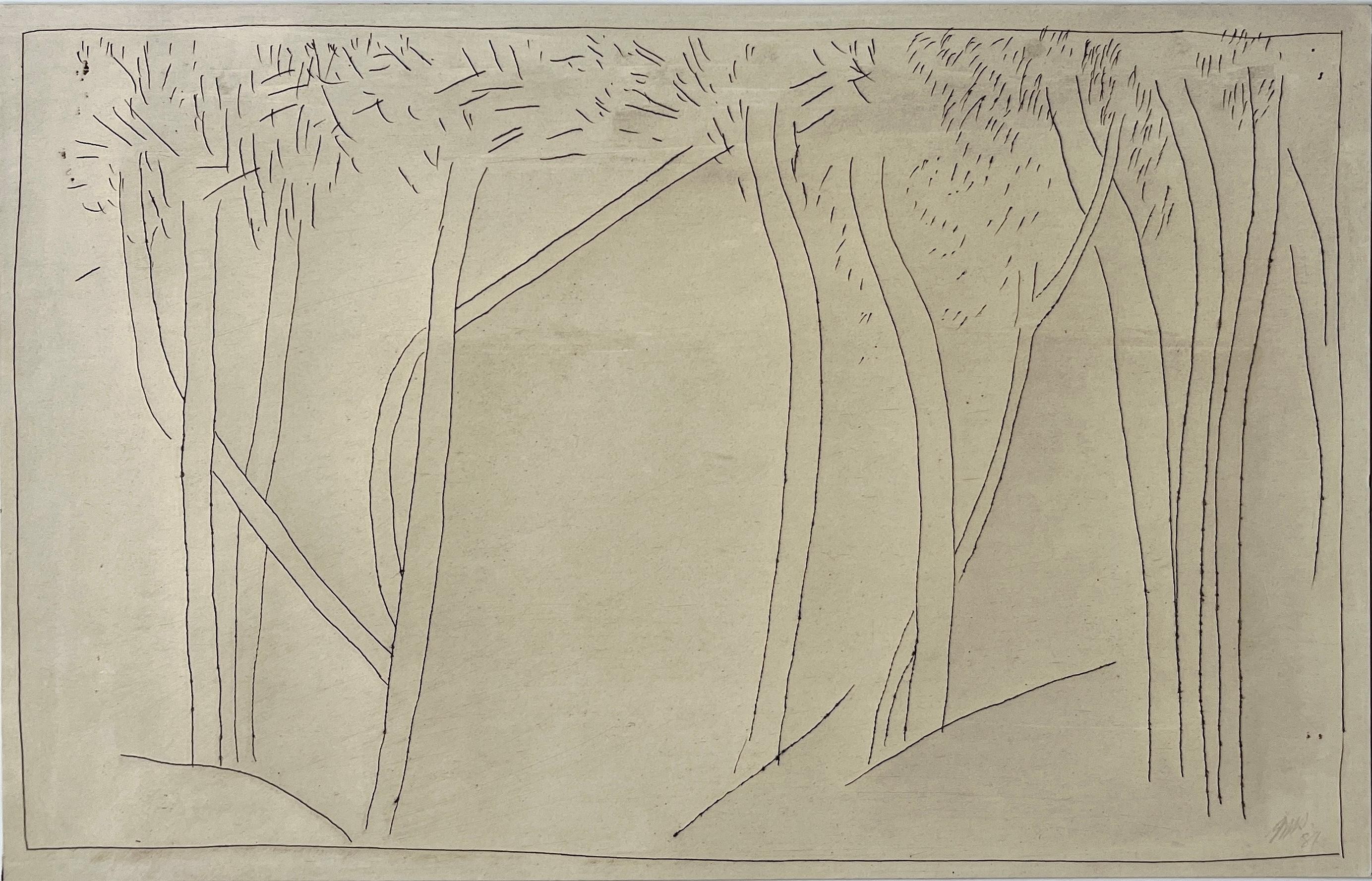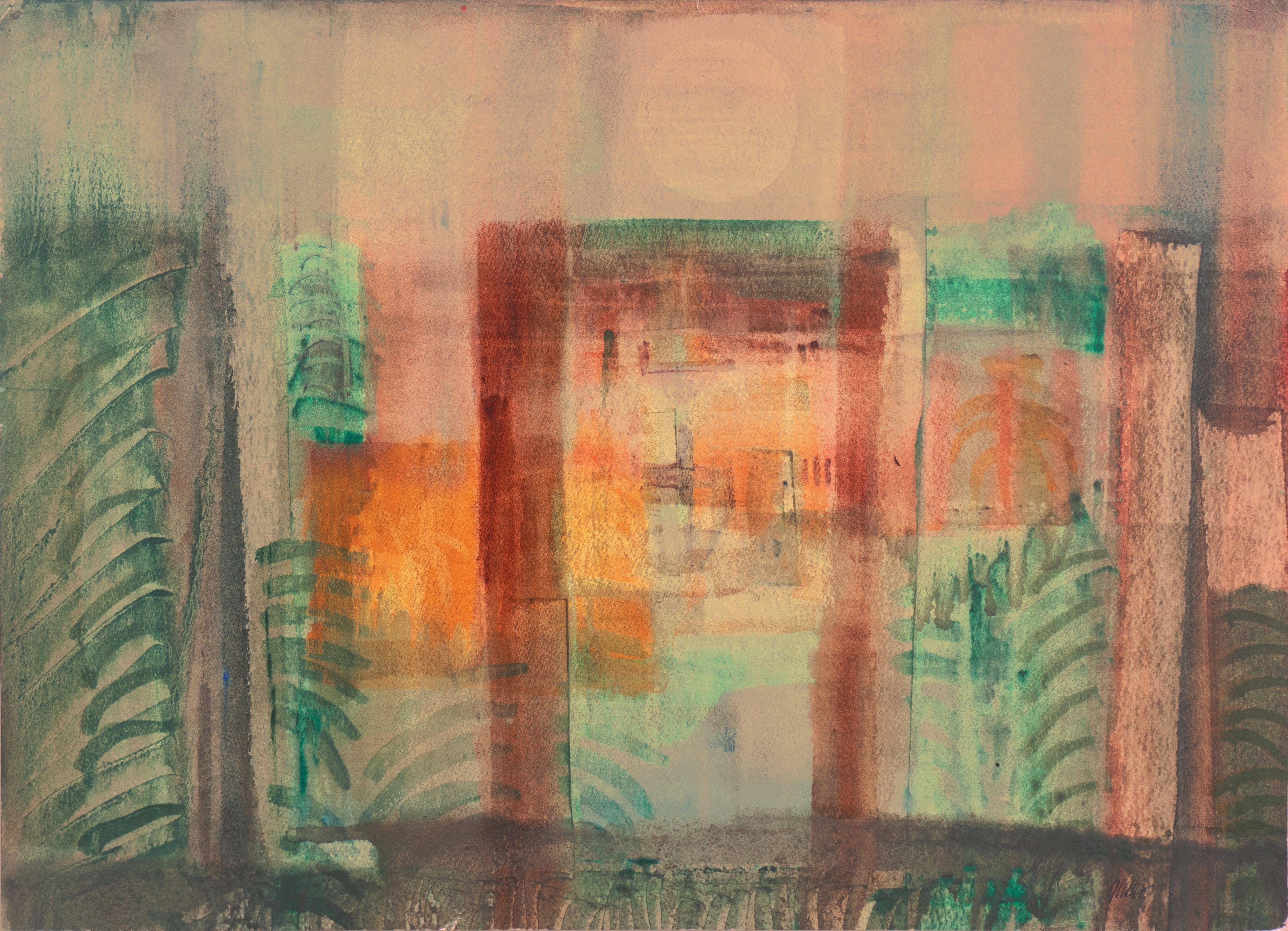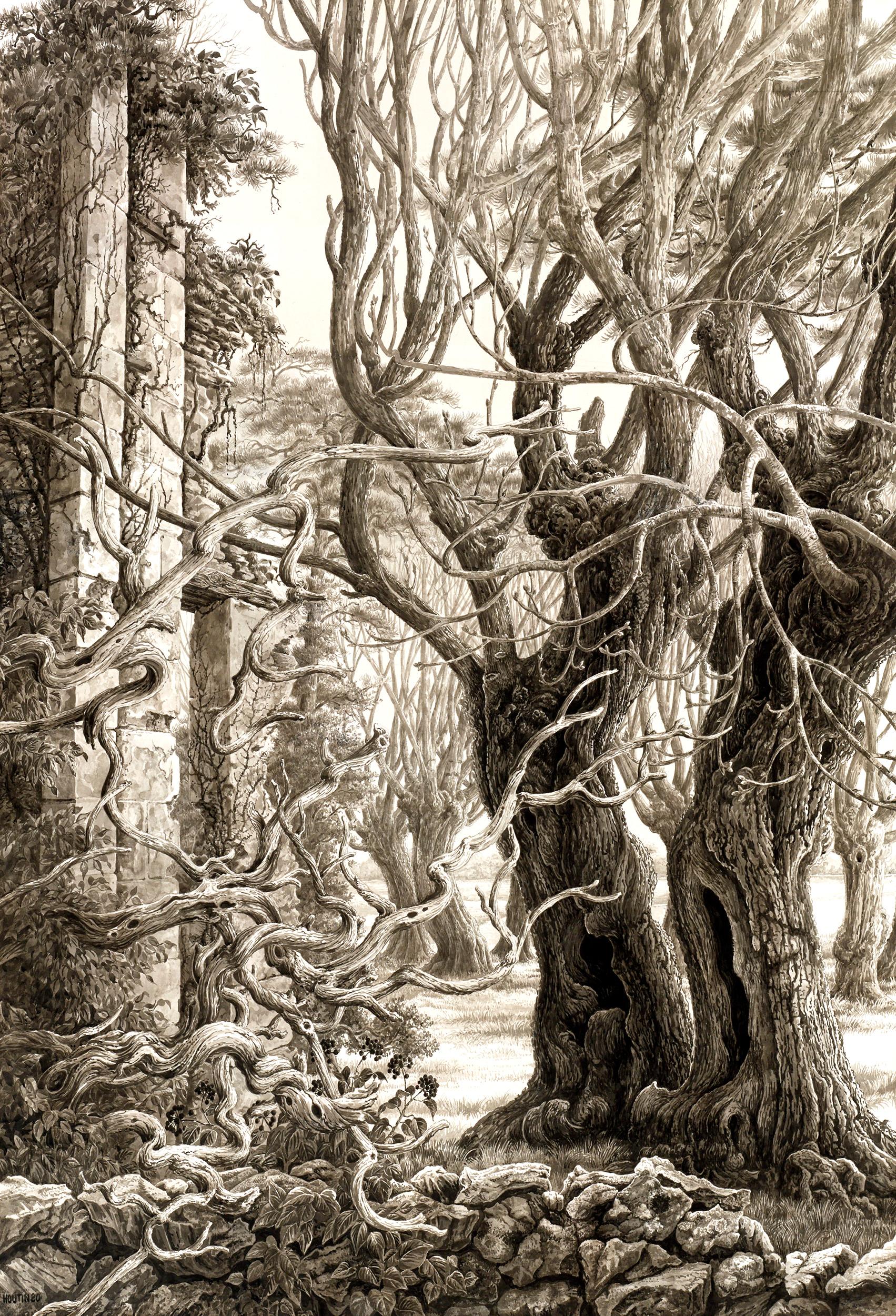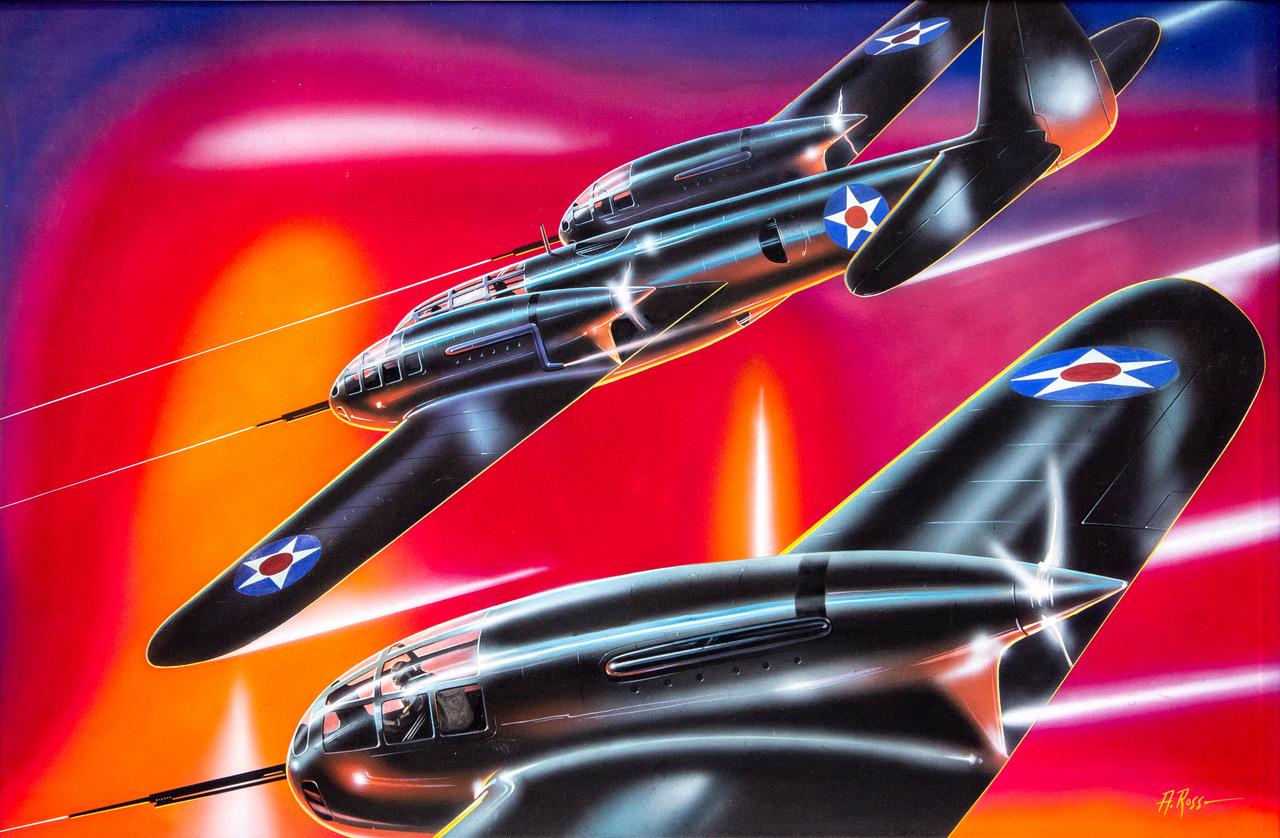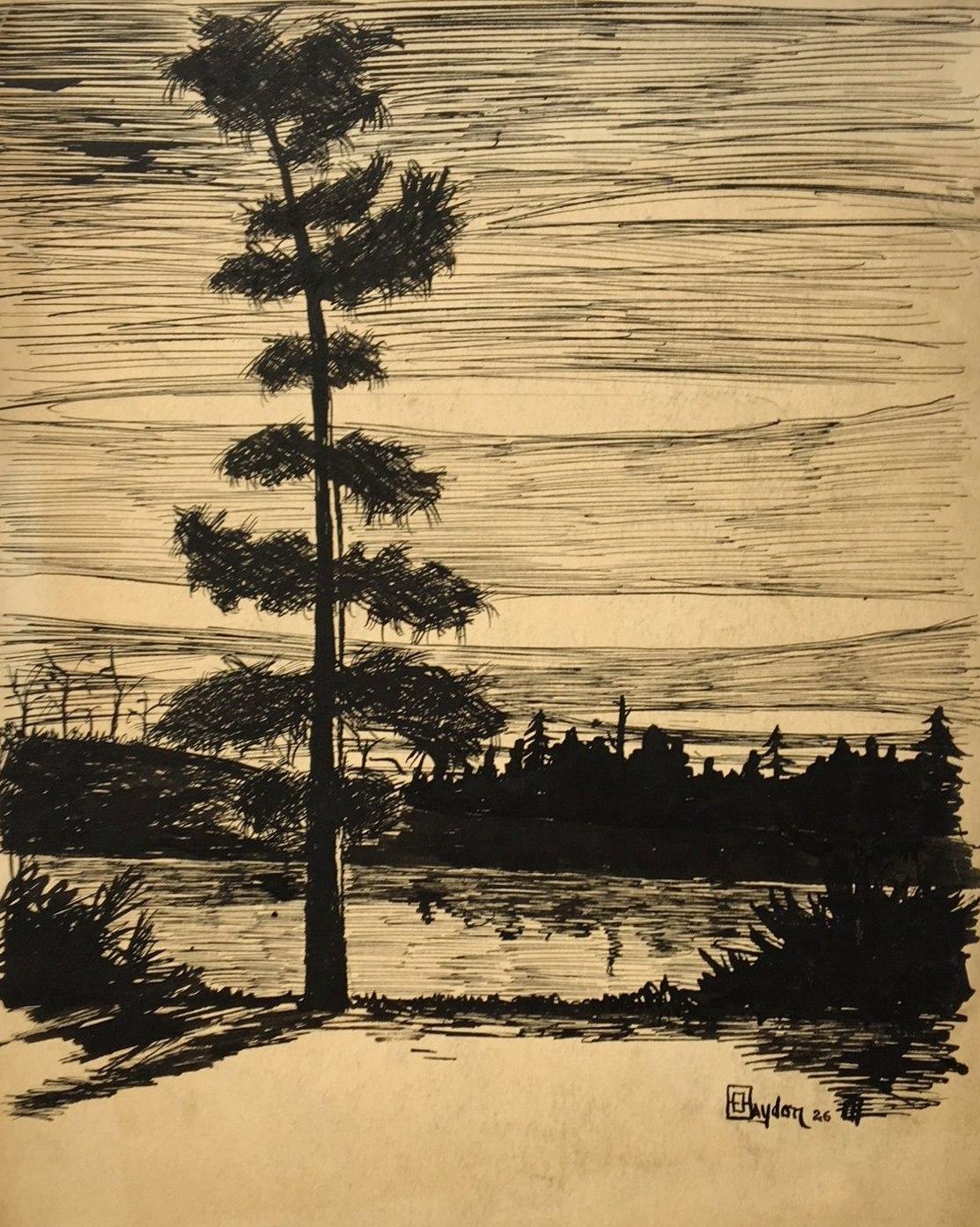Items Similar to untitled (Pueblo)
Want more images or videos?
Request additional images or videos from the seller
1 of 9
Virginia Dehnuntitled (Pueblo)20th Century
20th Century
About the Item
Untitled (Taos Pueblo)
Ink on paper, 1985-1990
Signed by the artist in ink lower right (see photo)
An early New Mexico period work, created shortly after the artist moved from New York.
Provenance: estate of the artist
Dehn Heirs
Condition: Excellent
Image/sheet size: 13 1/8 x 18 1/2 inches
Virginia Dehn
From Wikipedia, the free encyclopedia
Virginia Dehn
Virginia Dehn in her studio in Santa Fe
Virginia Dehn (née Engleman) (October 26, 1922 – July 28, 2005) was an American painter and printmaker. Her work was known for its interpretation of natural themes in almost abstract forms. She exhibited in shows and galleries throughout the U.S. Her paintings are included in many public collections.
Life
Dehn was born in Nevada, Missouri on October 26, 1922.] Raised in Hamden, Connecticut, she studied at Stephens College in Columbia, Missouri before moving to New York City. She met the artist Adolf Dehn while working at the Art Students League. They married in November 1947. The two artists worked side by side for many years, part of a group of artists who influenced the history of 20th century American art. Their Chelsea brownstone was a place where artists, writers, and intellectuals often gathered.
Early career
Virginia Dehn studied art at Stephens College in Missouri before continuing her art education at the Traphagen School of Design, and, later, the Art Students League, both located in New York City. In the mid-1940s while working at the Associated American Artists gallery, she met lithographer and watercolorist Adolf Dehn. Adolf was older than Virginia, and he already enjoyed a successful career as an artist. The two were married in 1947 in a private ceremony at Virginia's parents house in Wallingford, Connecticut.
Virginia and Adolf Dehn
The Dehns lived in a Chelsea brownstone on West 21st Street where they worked side by side. They often hosted gatherings of other influential artists and intellectuals of the 20th century. Among their closest friends were sculptor Federico Castellón and his wife Hilda; writer Sidney Alexander and his wife Frances; artists Sally and Milton Avery; Ferol and Bill Smith, also an artist; and Lily and Georges Schreiber, an artist and writer. Bob Steed and his wife Gittel, an anthropologist, were also good friends of the Dehns. According to friend Gretchen Marple Pracht, "Virginia was a glamorous and sophisticated hostess who welcomed visitors to their home and always invited a diverse crowd of guests..." Despite their active social life, the two were disciplined artists, working at their easels nearly daily and taking Saturdays to visit galleries and view new work.
The Dehns made annual trips to France to work on lithographs at the Atelier Desjobert in Paris. Virginia used a bamboo pen to draw directly on the stone for her lithographs, which often depicted trees or still lifes. The Dehns' other travels included visits to Key West, Colorado, Mexico, and countries such as Greece, Haiti, Afghanistan, and India.
Dehn's style of art differend greatly from that of her husband, though the two sometimes exhibited together. A friend of the couple remarked, "Adolf paints landscapes; Virginia paints inscapes." Virginia Dehn generally painted an interior vision based on her feelings for a subject, rather than a literal rendition of it.] Many of her paintings consist of several layers, with earlier layers showing through. She found inspiration in the Abstract Expressionism movement that dominated the New York and Paris art scenes in the 1950s. Some of her favorite artists included Adolf Gottileb, Rothko, William Baziotes, Pomodoro, and Antonio Tapies.
Dehn most often worked with bold, vibrant colors in large formats. Her subjects were not literal, but intuitive. She learned new techniques of lithography from her husband Adolf, and did her own prints. Texture was very important to her in her work. Her art was influenced by a variety of sources. In the late 1960s she came across a book that included photographs of organic patterns of life as revealed under a microscope. These images inspired her to change the direction of some of her paintings. Other influences on Dehn's art came from ancient and traditional arts of various cultures throughout the world, including Persian miniatures, illuminated manuscripts, Dutch still life painting, Asian art, ancient Egyptian artifacts, and work by Giotto, Monet, Vuillard, Munch, and Bonnard, mixed with the modernism of the New York art scene. Her husband was a constant inspiration until his death in 1968.]
Later career
In the 1970s, Dehn began making large mixed media paintings with overlays of clay and acrylic. She moved from New York City to Santa Fe in 1985. She enjoyed the sense of space and calm there that could not be found in New York City. After moving to New Mexico, some of her paintings began to take on a sculptural quality, as she began working more with materials such as clay and metallic substances into her paintings. The metallic colors she used in some works showed her interest in the interaction of light and matter. The petroglyphs of the southwest interested her, and along with her study of ancient artifacts from Egypt and Asia. Some of her works began to feature what looked like hieroglyphics.
During her artistic career, Dehn received fellowships from Yaddo, MacDowell Colony and Ossabaw Island Project. Her work was exhibited in shows and galleries throughout the country, and her paintings are part of many public collections. A traveling show sponsored by the Albuquerque Museum of Art and History called "Layerists in Multi-media" included her paintings. She was given the Salmagundi Club prize for a still life painting in 1968 by the National Academy of Design.
In her later years, Dehn continued to create as she retained a circle of devoted friends and admirers. Despite health struggles, she kept painting until her death at her home in Santa Fe on July 26, 2005. Her work is currently represented by Thomas French Fine Art and the Bundy Modern.
- Creator:Virginia Dehn (1922 - 2005, American)
- Creation Year:20th Century
- Dimensions:Height: 13.13 in (33.36 cm)Width: 18.5 in (46.99 cm)
- Medium:
- Movement & Style:
- Period:
- Condition:
- Gallery Location:Fairlawn, OH
- Reference Number:
About the Seller
5.0
Recognized Seller
These prestigious sellers are industry leaders and represent the highest echelon for item quality and design.
Platinum Seller
These expertly vetted sellers are 1stDibs' most experienced sellers and are rated highest by our customers.
Established in 1978
1stDibs seller since 2013
716 sales on 1stDibs
Typical response time: 1 hour
Associations
International Fine Print Dealers Association
- ShippingRetrieving quote...Ships From: Fairlawn, OH
- Return PolicyA return for this item may be initiated within 10 days of delivery.
More From This SellerView All
- Untitled (Hot Air Baloon Ascent and Spectators)By Joseph O'SickeyLocated in Fairlawn, OHUntitled (Hot Air Balloon Ascent and Spectators) Sepia wash on wove paper, 1985 Signed and dated in ink lower right corner From the artist's 1985 sketchbook Probably a view of Cape C...Category
1980s American Modern Landscape Drawings and Watercolors
MaterialsInk
- untitled (Pueblo)By Virginia DehnLocated in Fairlawn, OHUntitled (Taos Pueblo) Ink on paper, 1985-1990 Signed by the artist in ink lower right (see photo) An early New Mexico period work, created shortly after the artist moved from New York. Provenance: estate of the artist Dehn Heirs Condition: Excellent Image/sheet size: 13 1/8 x 18 1/2 inches Virginia Dehn From Wikipedia, the free encyclopedia Virginia Dehn Virginia Dehn in her studio in Santa Fe Virginia Dehn (née Engleman) (October 26, 1922 – July 28, 2005) was an American painter and printmaker. Her work was known for its interpretation of natural themes in almost abstract forms. She exhibited in shows and galleries throughout the U.S. Her paintings are included in many public collections. Life Dehn was born in Nevada, Missouri on October 26, 1922.] Raised in Hamden, Connecticut, she studied at Stephens College in Columbia, Missouri before moving to New York City. She met the artist Adolf Dehn while working at the Art Students League. They married in November 1947. The two artists worked side by side for many years, part of a group of artists who influenced the history of 20th century American art. Their Chelsea brownstone was a place where artists, writers, and intellectuals often gathered. Early career Virginia Dehn studied art at Stephens College in Missouri before continuing her art education at the Traphagen School of Design, and, later, the Art Students League, both located in New York City. In the mid-1940s while working at the Associated American Artists gallery, she met lithographer and watercolorist Adolf Dehn. Adolf was older than Virginia, and he already enjoyed a successful career as an artist. The two were married in 1947 in a private ceremony at Virginia's parents house in Wallingford, Connecticut. Virginia and Adolf Dehn The Dehns lived in a Chelsea brownstone on West 21st Street where they worked side by side. They often hosted gatherings of other influential artists and intellectuals of the 20th century. Among their closest friends were sculptor Federico Castellón and his wife Hilda; writer Sidney Alexander and his wife Frances; artists Sally and Milton Avery; Ferol and Bill Smith, also an artist; and Lily and Georges Schreiber, an artist and writer. Bob Steed and his wife Gittel, an anthropologist, were also good friends of the Dehns. According to friend Gretchen Marple Pracht, "Virginia was a glamorous and sophisticated hostess who welcomed visitors to their home and always invited a diverse crowd of guests..." Despite their active social life, the two were disciplined artists, working at their easels nearly daily and taking Saturdays to visit galleries and view new work. The Dehns made annual trips to France to work on lithographs at the Atelier Desjobert in Paris. Virginia used a bamboo pen to draw directly on the stone for her lithographs, which often depicted trees or still lifes. The Dehns' other travels included visits to Key West, Colorado, Mexico, and countries such as Greece, Haiti, Afghanistan, and India. Dehn's style of art differend greatly from that of her husband, though the two sometimes exhibited together. A friend of the couple remarked, "Adolf paints landscapes; Virginia paints inscapes." Virginia Dehn generally painted an interior vision based on her feelings for a subject, rather than a literal rendition of it.] Many of her paintings consist of several layers, with earlier layers showing through. She found inspiration in the Abstract Expressionism movement that dominated the New York and Paris art scenes in the 1950s. Some of her favorite artists included Adolf Gottileb, Rothko, William Baziotes, Pomodoro, and Antonio Tapies. Dehn most often worked with bold, vibrant colors in large formats. Her subjects were not literal, but intuitive. She learned new techniques of lithography from her husband Adolf, and did her own prints. Texture was very important to her in her work. Her art was influenced by a variety of sources. In the late 1960s she came across a book that included photographs of organic patterns of life as revealed under a microscope. These images inspired her to change the direction of some of her paintings. Other influences on Dehn's art came from ancient and traditional arts of various cultures throughout the world, including Persian miniatures, illuminated manuscripts, Dutch still life painting, Asian art, ancient Egyptian artifacts...Category
Early 20th Century American Modern Landscape Drawings and Watercolors
MaterialsInk
- The Duomo, FlorenceBy Donald Shaw MacLaughlanLocated in Fairlawn, OHThe Duomo, Florence Watercolor, 1914 Signed and dated lower center edge (see photo) Florence Cathedral, formally the Cattedrale di Santa Maria del Fiore, is the cathedral of Florence, Italy. It was begun in 1296 in the Gothic style to a design of Arnolfo di Cambio and was structurally completed by 1436, with the dome engineered by Filippo Brunelleschi. Condition: Excellent Image size: 16 3/4 x 14 1/2 inches Frame size: 24 1/4 x 22 inches Donald Shaw MacLaughlan was born in Charlottetown, Prince Edward Island, Canada on November 9, 1876. His family moved to Boston, Massachusetts in 1890 where he began to experiment with different art media; watercolor, oil painting and finally, etching – with a few attempts at lithography. He spent much of his early years at the Boston Public Library studying the work of printmakers, from Durer and Rembrandt to the 18th century English, French and Italian masters. Like many American artists of the time MacLaughlan traveled to Europe to study in Paris, enrolling in the Ecole des Beaux Arts and studied further with Jean Leon Gerome and Jean Paul Laurens. In 1899 he began producing etchings, which became his major interest until his death in 1938. He became acquainted with James NcNeill Whistler (1834-1903) and other artists who created etchings and spent time studying the etchings of Rembrandt van Rijn (1606-1669) and other old masters in the collection of the Bibliothèque Nationale. Both Rembrandt and Whistler would have major influences on his art. In 1900 he created a set of 25 etched views of Paris and in 1901 exhibited two etchings in the Salon de la Société Nationale des Beaux-Arts. He returned to the U.S. in 1903, then went back to Paris the following year. He traveled extensively in Europe, visiting England, Switzerland, Italy and Spain as well as various locales in France. His etched views of Venice were well-known. MacLaughlan exhibited views of Paris, Rouen, Normandy and Italy in 1906 in a solo show at the American Art Association Galleries in Paris. He also displayed his work in the 1906 exhibitions of the Société Nationale des Beaux-Arts and the Société des Peintres-Graveurs Français. MacLaughlan even instructed other expatriate Canadian artists then living in Paris, most notably Clarence...Category
1910s American Modern Landscape Drawings and Watercolors
MaterialsWatercolor
- untitled (Rocks along the Coast)By William C. GrauerLocated in Fairlawn, OHuntitled (Rocks along the Coast) Gouache and watercolor on paper, c. 1950 Signed with the estate stamp signature lower left (see photo) This is a preliminary study for a large exhibition painting...Category
1950s American Modern Drawings and Watercolor Paintings
MaterialsGouache
- Untitled (West Virginia fam valley and blue hills)By William C. GrauerLocated in Fairlawn, OHAfter creating murals for the Greenbrier Hotel in White Sulfur Springs, West Virginia in 1932, together Grauer and his wife founded and co-directed the successful Old White Art Colony, School and Gallery, which they continued to frequent during the summer months in the 1930s and 1940s. Grauer’s involvement in West Virginia also included his West Virginia murals for the West Virginia exhibitions at the 1933 Century of Progress Exhibition in Chicago and the 1939 World’s Fair in New York City. William C. Grauer (1895-1985) William C. Grauer (1895-1985) was born in Philadelphia to German immigrant parents. After attending the Philadelphia Museum School of Industrial Art, Grauer received a four year scholarship from the City of Philadelphia to pursue post graduate work. It was during this time that Grauer began working as a designer at the Decorative Stained Glass Co. in Philadelphia. Following his World War I service in France, Grauer moved to Akron, Ohio where he opened a studio in 1919 with his future brother-in-law, the architect George Evans Mitchell. Soon, the Rorimer-Brooks design company, the developer Van Swerngen brothers, as well as the Sterling Welch and Halle Bros. department stores realized the extent of Grauer's talent and eagerly employed him. Grauer’s work during this time included architectural renderings for Shaker Square, Moreland Courts, and other many other projects commissioned by Cleveland architects. Grauer also remained true to his roots as a master designer of stained glass windows. With his work in such high demand, Grauer received a commission in 1921 to paint murals for the French Grill Room of the Kansas City Club...Category
1930s American Modern Landscape Drawings and Watercolors
MaterialsWatercolor
- Staten IslandBy Robert HallowellLocated in Fairlawn, OHStaten Island Watercolor on paper, c. 1928 Signed with the Estate stamp lower left Sheet size: 19 1/8 x 23 7/8 inches Titled on verso Part of small series of watercolors done of the ...Category
1920s American Modern Landscape Drawings and Watercolors
MaterialsWatercolor
You May Also Like
- Abstract "Tree Landscape" Ink Line Drawing 1981 American Modernist Jack HooperBy Jack HooperLocated in Arp, TXJack Hooper "Tree Landscape" 1981 Ink on glossy paper 11"x7" unframed Signed and dated in pencil lower right Embrace the serene beauty of nature through this abstract line drawing b...Category
Mid-20th Century American Modern Abstract Drawings and Watercolors
MaterialsPaper, Ink
- 'Evening Landscape' Bay Area Abstraction, San Francisco Museum of Fine Arts, CWSBy Robert George GilbergLocated in Santa Cruz, CASigned lower right, 'Gilberg' for Robert George Gilberg (American, 1911-1970) and painted circa 1965. Born in Oakland, Robert George Gilberg first studied at the Oakland Art Center during the 1930s. Following service during WWII, he settled in Nevada City, California where he lived and painted until shortly before his death in San Francisco. Gilberg exhibited widely and with success and was the recipient of numerous medals, prizes and juried awards, including at the San Francisco Museum of Fine Arts...Category
1960s American Modern Landscape Drawings and Watercolors
MaterialsPaper, Ink, Watercolor
- Les Jumeaux (The Twins)By François HoutinLocated in New Orleans, LASigned and dated "Houtin 20" (lower left) Indian ink wash on paper mounted on canvas This utopian gardenscape was composed by the celebrated French artist François Houtin. Executed ...Category
20th Century American Modern Landscape Drawings and Watercolors
MaterialsCanvas, Paper, Ink
- Georgetown (Church in the Mountains, Colorado), Modernist Landscape Ink DrawingBy Charles Ragland BunnellLocated in Denver, COGeorgetown, Colorado, vintage 1938 WPA era ink drawing/painting on paper of a church set in a rocky mountain landscape by Charles Bunnell (1897-1968). Black on a creamy white paper, signed and dated lower right, titled lower left. Presented in a custom frame with all archival materials, outer dimensions measure 16 ¼ x 14 ½ x 1¼ inches. Image size is 7 ¾ x 5 ¾ inches. Drawing is clean and in good vintage condition - please contact us for a detailed condition report. Provenance: Estate of Charles Ragland Bunnell Expedited and international shipping is available - please contact us for a quote. About the Artist: Charles Bunnell developed a love for art as a child in Kansas City, Missouri. Around 1915, Bunnell moved with his family to Colorado Springs, Colorado. He served in World War I and later used his GI Training to study at the Broadmoor Art Academy (later renamed the Colorado Springs Fine Arts Center) during 1922 and 1923. In 1922, he married fellow student, Laura Palmer...Category
1930s American Modern Landscape Drawings and Watercolors
MaterialsInk, Archival Paper
- Airacuda Fighter Planes Art Deco Machine Age 20th Century American ModernismLocated in New York, NYAiracuda Fighter Planes Art Deco Machine Age 20th Century American Modernism Arthur Rosenman Ross (1913 - 1981) Bell YFM-1 Airacuda Fighter Planes 17 1/2 x 26 1/2 inches Gouache, Airbrush and Ink on Illustration Board, 1938 Signed A. Ross lower right Provenance: Estate of the artist. BIO Arthur Rosenman Ross was a key figure in automotive design at General Motors during America's "Golden Age" of auto design, the 1930's through the 1950s. He attended the Art Institute of Chicago from age 17, exhibiting a special interest for automotive renderings and the female figure. In 1934, he changed his name from Rosenman to Ross, fearing his Jewish ancestry could prejudice his career prospects. At age 20, he turned down job offers from MGM Studios in Hollywood and Duesenberg to work at General Motors alongside the Legendary Harley Earl in 1935. He was hand picked by Mr. Earl and assigned to GM's War and Camouflage Division in 1937 through WW2. It was during this pivotal period in which he executed some extraordinary military aircraft artworks, likely used between GM and America's military aeronautics companies in design preparation for WW2. General Motors played an important role in helping America's aircraft manufacturers preceding and during the war. Just after the war in 1945, Mr. Ross was rewarded by GM, being made Chief Designer of Cadillac, then two years later becoming Chief at Oldsmobile until his retirement in 1959. He was in large part responsible for some of GM's classic Cadillac designs such as the Cadillac Sixty Special, Fleetwood, LaSalle and GM's first concept car, the extraordinary Buick Y-Job. Mr. Ross was an exceptionally charismatic and vivacious man who quite by chance, befriended His idol, Salvador Dali at GM in 1955. They talked about art, cars and girls late into the evening, according to his son, Carter Ross. He had a gift in rendering the erotic arts...Category
1930s American Modern Landscape Drawings and Watercolors
MaterialsInk, Gouache, Board
- Ink on Paper Drawing of a Cedar Tree and a Northern Lake by Artist Harold HaydonBy Harold HaydonLocated in Chicago, ILA 1926 ink on paper drawing of a Cedar tree and northern lake by artist Harold Haydon. Harold Emerson Haydon was born in Fort William, Ontario, Canada in 1909. Haydon came to Ch...Category
1920s American Modern Landscape Drawings and Watercolors
MaterialsPaper, Ink
Recently Viewed
View AllMore Ways To Browse
Virginia Artists
Virginia City
Virginia Study
Virginia Paris
October 26
Watercolor Landscapes Colorado
Watercolor Landscape Southwest
Watercolor Easel
Watercolor Prints Trees
Southwest Landscapes Photograph
Mexican Pueblo
Asian Antique Watercolor
Pueblo Painting
Bill Smith
Antique Persian Painting
20th Century Manuscripts
Thomas Holland Painting
The Stone House Watercolour
